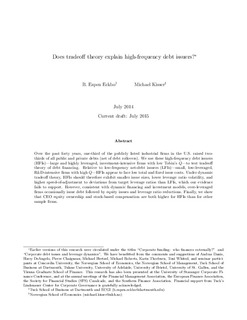| dc.description.abstract | Over the past forty years, one-third of the publicly listed industrial firms in the U.S. raised two-
thirds of all public and private debts (net of debt rollovers). We use these high-frequency debt issuers
(HFIs) - large and highly leveraged, investment-intensive firms with low Tobin's Q - to test tradeoff
theory of -debt financing. Relative to low-frequency net-debt issuers (LFIs) - small, low-leveraged,
R&D-intensive firms with high Q - HFIs appear to face low total and fixed issue costs. Under dynamic
tradeoff theory, HFIs should therefore exhibit smaller issue sizes, lower leverage ratio volatility, and
higher speed-of-adjustment to deviations from target leverage ratios than LFIs, which our evidence
fails to support. However, consistent with dynamic financing and investment models, over-leveraged
firms occasionally issue debt followed by equity issues and leverage ratio reductions. Finally, we show
that CEO equity ownership and stock-based compensation are both higher for HFIs than for other
sample firms. | nb_NO |
